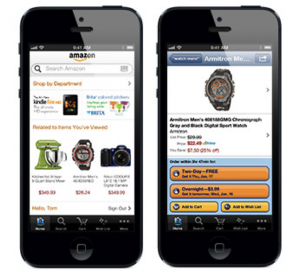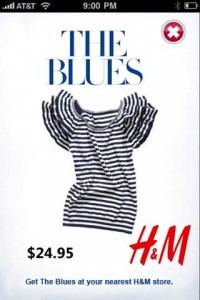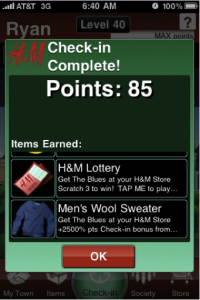Over the past few years, consumers have grown accustomed to having access to the Internet everywhere they go through their smartphones. This of course, has led companies to follow the consumer, by going mobile, too. According to a study done by the IMRG, 16% more people are using mobiles for fashion purchases than other online retail transactions – and retailers have only just caught up with this (2015). The percentage of fashion brands that own a mobile site has dramatically increased over the past three years, from less than half in 2012 to a staggering 80% in 2015.
‘We’re finding out how people shop now: They’re standing in a line at Starbucks, let’s say, and they start browsing on eBay. They see something they want and they buy it right there.’ – John Donahoe, CEO of eBay
A crucial thing for retailers to understand is how to reach the consumer in the best way, by implementing their online activity to the mobile device. Research undergone by the Pew Research Centre claimed that 74% of U.S. smartphone users used their phone to obtain location-based information (2012). Many retailers, such as Walgreens, have stepped up to the plate, by teaming up with apps such as FourSquare, a location based social networking website and app, to offer customers coupons as soon as they entre the Walgreens store. Macy’s offers free Wi-Fi in its stores, which means they can obtain consumer data instantly (by inviting consumers to log in to their network with their Facebook or e-mails) – and customers can scan QR codes on products to see online reviews, prices, and exclusive video content on fashion trends, advice, and tips (Brynjolfsso et al, 2013).
Location-based marketing efforts are becoming increasingly important for local retailers to implement, due to the growing competition from companies in other geographical areas. Local retailers can use location-based apps to rev sales activities up by sending out promotional messages to consumers within the vicinity, or even to people in a competitor’s store. Retailers are learning to respond to consumers using price scan apps in local stores, with more focused promotional offers.
Additionally, the design of the mobile pathway to a companies full website should be recognised. The footwear retailer Schuh, claims that 49% of their site visitors come from a mobile, a further 21% from a tablet; which leaves 30% of consumers visiting from a desktop computer (Durkin, 2015).
2 companies that have successfully gone mobile:
Amazon
Of course, Amazon is constantly being recognised for their effective mobile platforms, with its neat and systematic presentation. Additionally, Amazon’s well-curated, consumer-generated content and reviews creates an easy communication between the consumers and Amazon, while going through their purchase decision process (Brynjolfsso et al, 2013).

H&M
By partnering with MyTown, a location based app, H&M has gathered and used consumer information to track their locations. Through ‘gamifying’ – potential customers that are playing the game on a mobile device near an H&M store and check-in, H&M rewards them with virtual clothing and points. If consumers scan promoted products in store, it enters them in a sweepstakes to win prizes. Early results of these digital efforts showed that of the 700,000 customers who checked in online, 300,000 went into the store and scanned an item (Davenport et al, 2011).


Critical Analysis:
Avoid direct price comparisons:
Although consumers benefit from easy search, such advances can be damaging to sellers. Taking steps to make direct comparisons difficult can protect retailers from poaching by competitors and alleviate the effects of price competition (Brynjolfsso et al, 2013).
Keep it simple:
Retailers must keep up with the consumer. It’s all about user experience over driving conversion in an obvious way. A few years ago, with web, the more features on a website the better, however, on mobile, people are comfortable having a few number of apps and services that do one function. However, this one function must be done well, fast, and kept simple. Retailers will only be caught out if they don’t address this shift in consumer mentality (Durkin, 2015).
Lessons Learned:
- Focus on location – work with location-based apps to increase online/offline sales
- Make it fun for the consumer – why would they want to download your app if it doesn’t give them exclusive and additional benefits?
- Keep it simple and to the point – create a clean design so consumers don’t get lost and close the app
References:
Brynjolfsson,, E. (2013). Competing in the Age of Omnichannel Retailing. [online] MIT Sloan Management Review. Available at: http://sloanreview.mit.edu/article/competing-in-the-age-of-omnichannel-retailing/ [Accessed 29 Apr. 2016].
Chaffey, D. (2016). Mobile marketing statistics 2016. [online] Smart Insights. Available at: http://www.smartinsights.com/mobile-marketing/mobile-marketing-analytics/mobile-marketing-statistics/ [Accessed 29 Apr. 2016].
Davenport, T., Mule, L. and Lucker, J. (2011). Know What Your Customers Want Before They Do. [online] Spotlight. Available at: http://www.iei.liu.se/fek/svp/mafo/artikelarkiv/1.309630/GruppC1.KnowWhatCustomersWant.pdf [Accessed 29 Apr. 2016].
Davis, B. (2014). A list of 10 retail mobile apps that customers love. [online] Econsultancy. Available at: https://econsultancy.com/blog/64140-a-list-of-10-retail-mobile-apps-that-customers-love/ [Accessed 29 Apr. 2016].
Durkin, R. (2015). How fashion brands are setting trends in digital. [online] Econsultancy. Available at: https://econsultancy.com/blog/66501-how-fashion-brands-are-setting-trends-in-digital/ [Accessed 29 Apr. 2016].
J. Tyler, D. (2014). Segmenting the UK Mobile Fashion Consumer. [online] Aisel.aisnet.org. Available at: http://aisel.aisnet.org/cgi/viewcontent.cgi?article=1001&context=icmb2014 [Accessed 29 Apr. 2016].
Taylor, D. (2013). Predicting Mobile App Usage For Purchasing and Information Sharing. [online] Available at: http://www.davidgtaylor.net/tenure/research/2014IJRDM.pdf [Accessed 29 Apr. 2016].
In 2015, online retail sales were predicted to reach £52.25bn, a 16.2% increase from the previous year (Moth, 2015). These e-commerce trends are only expected to rise, and thus the attention retailers are giving to their digital retail platforms are crucial. According to a study by the Financial Times, British consumers spend an average of around 4.8 times more online than in-store (2014).
Of course, consumers still shop offline, thus understanding the difference in motivators behind offline and online shopping is important for companies who are threatened of e-commerce growth. A study by Brown (1988) suggested that consumers suffer non-monetary costs when shopping offline; time, effort, and psychological costs, in addition to the extra cost spent in store. However, a report published by the State of Retail in 2015 states that consumers prefer to shop offline, in physical retail stores:
‘The bottom line is customers value the personal experience of the physical store,” said Gary Ambrosino, CEO of TimeTrade. “We found that shoppers have done their shopping or discovery online, then go into the store to get help with their final purchase decision.’
Thus, the only stage of the consumer purchase decision process made offline is the purchase decision. Even the post purchase decision can be found online, through customer reviews.
Companies with a positive presence on review sites as well as other forms of social media will benefit from the mere exposure effect, in which consumers favour a product or company to which they have been previously exposed (Smith, 2012). A survey done by BrightLocal, found that an astounding 88% of consumers trust online reviews as much as a personal recommendation (DeMers, 2015). This viral word of mouth represents one of the fasts growing phenomena on the Internet, as social media and virtual communities provide platforms to tell the world how they feel about a product or company (Mangold & Smith, 2012). Social media has the potential to influence all stages of the consumption process, including awareness, information acquisition, attitudes, decision-making, and post purchase evaluation (Mangold & Faulds, 2009). Enabling customer reviews on the company’s site can also have a positive effect on the company’s organic search ranking in search engines (Colao, 2014). Both scholars and practitioners claim customer retention to be one of the critical success factors for retail businesses; the cost of acquiring new customers is five to seven times that of retaining existing ones (Doyle, 2003).
Motivations for online shoppers mirror that of offline shoppers, and can be seen as two: experiential (for fun) or goal directed (for efficiency). Additionally, scholars have also discovered that the higher playfulness associated with experiential behaviour results in a more positive mood, greater shopping satisfaction and a higher likelihood of impulse purchasing compared to goal-focused shopping (Wolfinbarger & Gilly, 2001).
So what should companies do on their digital platforms?
Be Playful With Your Consumers!
ASOS
ASOS, an online fashion retailer, regularly ‘gamifies’ the online shopping experience with competitions such as fashion bingo, matching celebrities with clothing and Pinterest competitions to win prizes. This particular ‘Love’ themed competition proved to be rather spot on; running around Valentines Day. With one winner every hour, and in one combined effort, ASOS had pulled off this campaign that would get them Facebook Activity, Tweets (with a hashtag trending), and extra visits to their sites (2011).
This particular ‘Love’ themed competition proved to be rather spot on; running around Valentines Day. With one winner every hour, and in one combined effort, ASOS had pulled off this campaign that would get them Facebook Activity, Tweets (with a hashtag trending), and extra visits to their sites (2011).
Jack Wills
 Another retailer using interactive games to retain customers is Jack Wills, in which customers can scan their gift guide Christmas calendar each day for a chance to win prizes. The key is to stay relevant; a calendar competition wouldn’t make much sense in April, right? Additionally, this gives consumers an incentive to keep coming back. Every. Single. Day.
Another retailer using interactive games to retain customers is Jack Wills, in which customers can scan their gift guide Christmas calendar each day for a chance to win prizes. The key is to stay relevant; a calendar competition wouldn’t make much sense in April, right? Additionally, this gives consumers an incentive to keep coming back. Every. Single. Day.
Missguided
 Missguided is another great example of retailer utilising the power of social media for consumer engagement. By inviting consumers to share selfies of themselves, with the hashtag #MissguidedActive, the retailer is recognised in the tag, the users are engaged, and it is relevant, by offering a prize of ‘Protein World’ goodies, a brand affiliated with healthy lifestyle.
Missguided is another great example of retailer utilising the power of social media for consumer engagement. By inviting consumers to share selfies of themselves, with the hashtag #MissguidedActive, the retailer is recognised in the tag, the users are engaged, and it is relevant, by offering a prize of ‘Protein World’ goodies, a brand affiliated with healthy lifestyle.
Conclusion
If companies want consumers to be talking about their products, they need to be active on their social media platforms. Social networking sites were found to be the most popular online venue for product discussions (Smith, 2012). According to a survey by eMarketer (December 2010), millennials are talking about products and services online more than the general population, and their preferred channels to do this are Facebook and company websites.
“Marketers must acknowledge the phenomenon of social media because it is becoming “the de facto modus operandi for consumers who are disseminating information on products and services” (Mangold & Faulds, 2009).
Thus, in order for companies to enhance the customer online shopping experience, they must bridge the gap between the stages of the purchasing decision. Consumers should be urged to read reviews on the company’s own website, then follow with an easy gateway towards the purchase, rather than purchasing offline. Additionally, in order to retain these consumers and boost online sales, companies must ensure they are playful with their online marketing, inviting consumers to engage through social media through competitions and prizes. Furthermore, during these ‘gamified’ marketing efforts, companies should ensure that through this engagement, consumers are invited to like, share, and post with a trending hashtag associated with the company.
Critical analysis
The emphasis on customers’ ‘willingness to participate’ in online communications is becoming crucial for the success of promotional activities. (Parent, Plangger, & Bal, 2011). This means that marketers need to implement social media as part of their marketing mix. This may be a timely and rather complex task, if the company’s current social media platforms are not used that often. This is also a ‘new’ phenomenon, therefore understanding and implementing it into a traditional company may seem strenuous.
The digital platforms in which consumers post their reviews/ratings such as Facebook, Twitter, YouTube and blogs should be carefully monitored for reviews concerning the company or product. This can be accomplished by keeping careful track of communications on and surrounding a Facebook page, by book marking relevant sites, and by subscribing to RSS feeds (Smith, 2012).
Lessons Learned:
- Allow reviews on your website, that way it’s easier to monitor
- Retain online shoppers by being playful: through interactive games, competitions, and prizes – always get the consumer involved
- Start a hashtag competition – ensure you invite consumers to like, share, and subscribe to the online platforms
References:
Bauer, H., Falk, T. and Hammerschmidt, M. (2006). eTransQual: A transaction process-based approach for capturing service quality in online shopping. Journal of Business Research, 59(7), pp.866-875.
Häubl, G. and Trifts, V. (2000). Consumer Decision Making in Online Shopping Environments: The Effects of Interactive Decision Aids. Marketing Science, 19(1), pp.4-21.
Khalifa, M. and Liu, V. (2007). Online consumer retention: contingent effects of online shopping habit and online shopping experience. European Journal of Information Systems, 16(6), pp.780-792.
Kim, J. and Park, J. (2005). A consumer shopping channel extension model: attitude shift toward the online store. Journal of Fashion Marketing and Management: An International Journal, 9(1), pp.106-121.
Mangold, W. and Smith, K. (2012). Selling to Millennials with online reviews. Business Horizons, 55(2), pp.141-153.
Roy Dholakia, R. and Uusitalo, O. (2002). Switching to electronic stores: consumer characteristics and the perception of shopping benefits. Intl J of Retail & Distrib Mgt, 30(10), pp.459-469.
Wolfinbarger, M. and Gilly, M. (2001). Shopping Online for Freedom, Control, and Fun.California Management Review, 43(2), pp.34-55.





